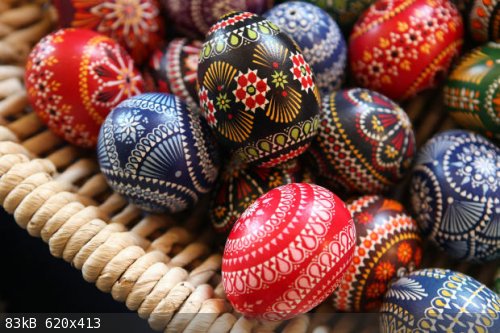Wendish Folklore Portfolio 9. PISANE JASTROWNE JAJA - Multi-colored Easter Eggs
9. PISANE JASTROWNE JAJA - Multi-colored Easter Eggs
Translated by Elmer Hohle

The egg has been the symbol for growth and fruitfulness since times of old. That's why a person would joyfully give presents of eggs at the
Spring-feast so that the indwelling life-power would transfer to the recipient.
As a sign of affection and for the joy of decorating, the eggs were colorfully painted. Of the three techniques, scratching, etching, and waxing, the
latter is no doubt the oldest art form. Each was characteristic of the residents of a particular local congregation.
The decorating was done with the following steps: First, the necessary utensils and equipment was prepared and assembled. Then either a turnip or a
potato was sliced in half and a bent spoon was stuck into it. The spoon was filled with bee wax and a lit candle was placed under it to melt the wax
enough so that it was fluid.
The tips of Goose feathers were trimmed at a sharp angled point. With a scissor the tip was then shaped into three or four pointed corners of other
suitable configurations. In addition, needle stick pins, with various sized heads, were stuck into thin wooden sticks.
Next came the preparation of the colors - in earlier times a person used natural stuff. Now a days one uses all kind of shades of hot water soluble
egg coloring. After all this has been prepared, begins the painting of the eggs. The pin head of a larger pin is dipped into the melted wax, and the
point is quickly placed on the egg, or optionally, tapered lines are drawn which join to form a little rose or flower.
The feather quill, was dipped into the wax and applied to the egg, produced geometric forms, which were used to create flowers, borders, and bows.
Once the egg was covered with wax designs, one would lay it in the desired warm colored brew. Through repeated waxing and dipping in various colored
brews, a person could create multi-colored eggs. In the final step, the wax markings on the egg were warmed over the candle flame and wiped off with a
rag.
|